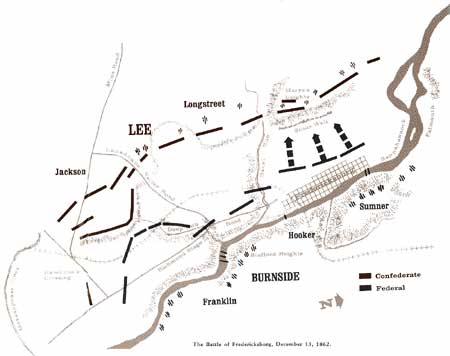|
FREDERICKSBURG and SPOTSYLVANIA COUNTY BATTLEFIELDS MEMORIAL National Military Park |
 |

(click on image for an enlargement in a new window)
THE FATAL DELAY
Fortunately for Lee, Burnside was not hurrying either. That the pontoons needed to bridge the river were late arriving was not his fault, to be sure. But even after they finally arrived on November 25, Burnside made no attempt to cross for almost 3 weeks. His feeble explanation for this inexcusable delay was contained in his official report:
By this time [November 25] the enemy had concentrated a large force on the opposite side of the river, so that it became necessary to make arrangements to cross in the face of a vigilant and formidable foe. These arrangements were not completed until about December 10.
The "large force" referred to was Longstreet's corps of about 35,000 men (Jackson's corps had not yet arrived). Burnside commanded an army of approximately 130,000 men.
Lee took advantage of the delay to make his position behind Fredericksburg almost impregnable. He would not attempt to dispute the Federal crossing of the river because of the topography of the area. The Rappahannock here takes a wide swing to the south to cut between two elevated ridges. The Federals occupied Stafford Heights on the east, commanding the river and the city. Had the Confederates opposed the crossing, Federal artillery literally would have been looking down their throats. Instead, Lee chose to fortify the heights west of the city, varying from 1 to 2 miles distant from the river. Here, along a 7-mile front that stretched from the Rappahannock to Massapponax Creek, he placed Longstreet on the left and Jackson on the right, with over 300 pieces of artillery in support. His force in this line consisted of approximately 75,000 men.
Longstreet's position, along a ridge behind the city known as Marye's Heights, was further fortified by a sunken road and a stone wall at the base of the heights, providing excellent protection for infantry. An open plain about 2 miles wide lay between Jackson's position and the river. To facilitate troop movements during the battle, Lee constructed a military road between the two corps.
Burnside's delay was confusing, even to the Confederates. As days passed with no attempt made to force a crossing, Lee continued to strengthen his position, although he became somewhat apprehensive that Burnside's hesitation suggested "the probability that he is waiting for expected operations elsewhere."
Actually, Lee had no cause for alarm. Burnside was merely trying to decide what to do. It is a military axiom that strategy is the art of bringing the enemy to battle on terms disadvantageous to him and advantageous to yourself. In the positions of the two armies at Fredericksburg after Burnside's delay, it was obvious even to the men in the ranks that Lee had all the advantages. Despite this strategic handicap, Burnside finally decided to attack.

|
|
Last Modified: Mon, Dec 2 2002 10:00:00 am PDT |


